| Revision as of 15:19, 5 July 2022 editGTNO6 (talk | contribs)389 edits Undid revision 1096608533 by 150.129.104.41 (talk)Tags: Undo Reverted Mobile edit Mobile web edit Advanced mobile edit← Previous edit | Revision as of 15:20, 5 July 2022 edit undoGTNO6 (talk | contribs)389 editsNo edit summaryTags: Reverted Mobile edit Mobile web edit Advanced mobile editNext edit → | ||
| Line 25: | Line 25: | ||
| | type = Igneous | | type = Igneous | ||
| }} | }} | ||
| '''Girnar''' is an ancient hill in ], ], India.Girnar |
'''Girnar''' is an ancient hill in ], ], India.Girnar is a hill in ], ], India. It is a (''Shashwat Tirth'') and one of the four holiest ancient pilgrimages of Jains along with ], ] and ]. Here the 22nd ], supreme preacher of Jain dharma, ] attained nirvana. It is believed to be place where next 24 Tirthankars will attain nirvana in future. The place is also an abode of some newly built Hindu temples. | ||
| There are total 9999 steps towards Urjayant Shikhar (Neminath Tonk) where the footprint of Neminath Bhagwan is situated. It is the place from where he attained salvation (moksha). | There are total 9999 steps towards Urjayant Shikhar (Neminath Tonk) where the footprint of Neminath Bhagwan is situated. It is the place from where he attained salvation (moksha). | ||
Revision as of 15:20, 5 July 2022
Mountain in GujaratThis article has multiple issues. Please help improve it or discuss these issues on the talk page. (Learn how and when to remove these messages)
|
| Girnar Mount | |
|---|---|
| ગિરનાર પર્વત Girinagar Revatak Parvata | |
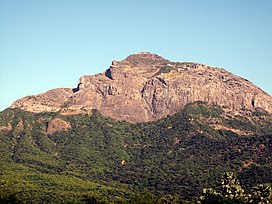 Mount Girnar from Bhavnath Mount Girnar from Bhavnath | |
| Highest point | |
| Elevation | 1,069 m (3,507 ft) |
| Listing | List of Indian states and territories by highest point |
| Coordinates | 21°29′41″N 70°30′20″E / 21.49472°N 70.50556°E / 21.49472; 70.50556 |
| Geography | |
  | |
| Geology | |
| Mountain type | Igneous |
Girnar is an ancient hill in Junagadh, Gujarat, India.Girnar is a hill in Junagadh, Gujarat, India. It is a (Shashwat Tirth) and one of the four holiest ancient pilgrimages of Jains along with Shikharji, Shantrujay and Nalanda Pawapuri. Here the 22nd Tirthankar, supreme preacher of Jain dharma, Lord Neminath attained nirvana. It is believed to be place where next 24 Tirthankars will attain nirvana in future. The place is also an abode of some newly built Hindu temples.
There are total 9999 steps towards Urjayant Shikhar (Neminath Tonk) where the footprint of Neminath Bhagwan is situated. It is the place from where he attained salvation (moksha).
The 5th peak which houses these footprints of Lord Neminath has recently been illegally encroached upon by Hindu Pandas since 2010 and illegal construction has been carried out by them at the peak during the recent COVID-19 pandemic.
Geology
Mount Girnar is a major igneous plutonic complex which intruded into the basalts towards the close of the Deccan Trap period. The rock types identified in this complex are gabbros (tholeiitic and alkalic), diorites, lamprophyres, alkali-syenites and rhyolites. The parent gabbroic magma is shown to have given rise in sequence to diorites, lamprophyres and alkali-syenites. The rhyolite, though earlier considered a product of differentiation, is now believed to be an independent magma without any genetic link with the gabbro and its variants.
History

Ashoka's edicts at Mount Girnar, Junagadh
Fourteen of Ashoka's Major Rock Edicts, dating to circa 250 BCE, are inscribed on a large boulder that is housed in a small building located outside the town of Junagadh on Saurashtra peninsula in the state of Gujarat, India. It is located on Girnar Taleti road, at about 2 km (1.2 mi) far from Uperkot Fort easterly, some 2 km before Girnar Taleti. An uneven rock, with a circumference of seven meters and a height of ten meters, bears inscriptions etched with an iron pen in Brahmi script in a language similar to Pali and date back to 250 BCE, thus marking the beginning of written history of Junagadh.
On the same rock there are inscriptions in Sanskrit added around 150 CE by Mahakshatrap Rudradaman I, the Saka (Scythian) ruler of Malwa, a member of the Western Satraps dynasty (see Junagadh rock inscription of Rudradaman). The edict also narrates the story of Sudarshan Lake which was built or renovated by Rudradaman I, and the heavy rain and storm due to which it had broken.
Another inscription dates from about 450 CE and refers to Skandagupta, the last Gupta Empire.
The protective building around the edicts was built in 1900 by Nawab Rasool Khan of Junagadh State at a cost of Rs 8,662. It was repaired and restored in 1939 and 1941 by the rulers of Junagadh. The wall of the structure had collapsed in 2014.
A much smaller replica of these Girnar edicts has been positioned outside the entrance of the National Museum in Delhi.
Similarly, inside the Parliament Museum at New Delhi, an exhibit replicates the act of artists sculpting inscriptions of Girnar edict on a rock.
-
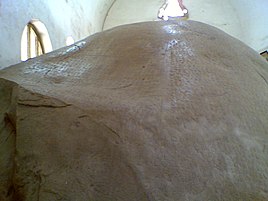 Ashoka's Rock Edict
Ashoka's Rock Edict
-
 Housing for Ashoka's edicts.
Housing for Ashoka's edicts.
-
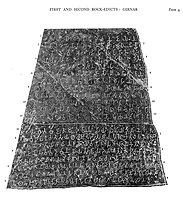 Estampage of a part of the inscriptions.
Estampage of a part of the inscriptions.
-
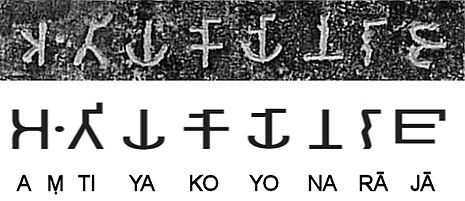 "Aṃtiyako Yona Rājā" (𑀅𑀁𑀢𑀺𑀬𑀓𑁄𑀬𑁄𑀦𑀭𑀸𑀚𑀸, "The Greek king Antiochos"), mentioned in Major Rock Edict No.2, at Girnar.
"Aṃtiyako Yona Rājā" (𑀅𑀁𑀢𑀺𑀬𑀓𑁄𑀬𑁄𑀦𑀭𑀸𑀚𑀸, "The Greek king Antiochos"), mentioned in Major Rock Edict No.2, at Girnar.
Girnar Ropeway
Main article: Girnar ropeway
Girnar ropeway is a ropeway on Mount Girnar which is Asia's longest ropeway. First proposed in 1983, the construction started only in September 2018 due to government approval delays and litigation. The construction and operation is managed by Usha Breco Limited. The project was inaugurated on 24 October 2020 by now Prime Minister Narendra Modi. The temple was constructed in 12th century by a Jain Minister, Vastupal. The ropeway is 2,320 metres (7,600 ft) long, takes passengers 850 metres (2,800 ft) above the hill to the Ambika Jain temple It connects Girnar taleti to Jain goddess Ambika Yakshini (Ambaji) temple within 10 minutes of ropeway ride.

Jain Temples
Main article: Girnar Jain temples-
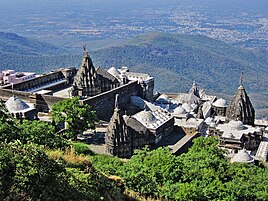 Jain Temple on Girnar mountain
Jain Temple on Girnar mountain
-
 Neminath temple
Neminath temple
-
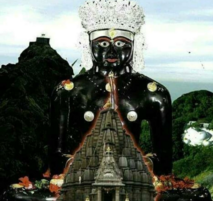 Tirthankar Neminath
Tirthankar Neminath
-
 Kumarapala temple
Kumarapala temple
-
 Vastupala Vihara
Vastupala Vihara
-
 Samprati Raja temple
Samprati Raja temple
-
 Chaumukhji Temple
Chaumukhji Temple
-
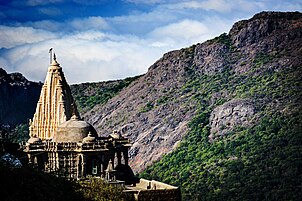 Dharamchand Hemchand temple
Dharamchand Hemchand temple
Tanks
Outside to the north of the Kumarapala's temple, there is the Bhima Kunda, a tank measuring 70 feet by 50 feet. Below it and on the verge of the cliff is a smaller tank of water and near it a small canopy supported by three roughly hewn pillars and a piece of rock containing a short octagonal stone called Hathi pagla or Gajapada, the elephant foot, a stratum on the top of which is of light granite and the rest of dark the lower part is immersed in water most of the year.
As per historical records, Sajjana, the minister of Chaulukya king Siddharaja Jayasimha, built the Neminatha temple using the state treasury. When he collected the funds to return as a compensation, the king declined to accept it so the funds were used to built the temple.
Sahastraphana (thousand hooded) Parshwanatha, the image which was consecrated in 1803 CE (VS 1459) by Vijayajinendra Suri, is currently the central deity in the temple. The temple originally housed the golden image of Mahavira and brass images of Shantinatha and Parshwanatha on its sides.
The east facing temple has 52 small shrines surrounding the central temple. It has an open portico with ceilings with fine carvings. In the bhamti or cloisters surrounding the court, there are also some remarkable designs in carved ceilings. The roof of the rangamandapa has fine carvings. The shrine proper must have been removed and replaced with new one at the end of the sixteenth century or the start of the seventeenth century. It is known that Karmachandra Bachchhavat, minister of the king of Bikaner, had sent a funds to renovate temple in Shatrunjaya and Girnar under Jinachandrasuri IV of Kharatara Gaccha during the reign of Akbar. There is a shrine housing replica of Ashtapada hill in the south, shrine with Shatrunjayavatar in west, behind the main temple, and Samet Shikhar (or Nandishwar Dwipa) in north.
Girnar's Initial trek
The base of the mountain, known as Girnar Taleti, is about 4 km east of the center of Junagadh. There are temples and other sacred places all along this stretch.
The traveller, in order to reach Girnar Taleti from Junagadh city, will pass through the Wagheshwari or Vagheshwari Gate (Girnar Darwaza), which is close to the Uparkot fort area, Easterly.
At about 200 metres from the gate, to the right of the road, is the Temple of Wagheshwari (Upale Vagheshwari maa), which is joined to the road by a causeway about 150 yards long. An ancient Verai Mata mandir and a modern Gayatri Shakti Peeth mandir are nearby.
About a furlong beyond this is a stone bridge, and just beyond it on the right are the Ashoka's Major Rock Edicts. The edicts are inscribed high up on a large, domed mass of black granite measuring roughly 20 feet x 30 feet. The inscription is in Brahmi script. They primarily are written in praise of 22nd Tirthankar Lord Neminath and how he attained salvation from the 5th and highest peak of the holy mountain. They confirm the presence of a pure and sacred Jain site along with the sacred footprints of Lord Neminath on the 5th peak / Ujjayanta. On the same rock can be found an inscription of the Western Satrap ruler Rudradaman, the Junagadh rock inscription of Rudradaman.
On leaving Ashoka's edicts, the route crosses the handsome bridge over the Sona-rekha, which here forms a fine sheet of water over golden sand, then passes a number of temples, at first on the left bank of the river and then on the right, to the largest of the temples. This is dedicated to Damodar, a name of Krishna, from Dam, a rope, because by tradition his mother in vain attempted to confine him with a rope when a child. The reservoir, Damodar Kund, at this place is accounted very sacred.
Next is an old shrine of Bhavnath, a form of Shiva, close to Girnar Taleti; Mrigi kund and Sudharshan lake are nearby.
Most persons who are not active climbers will probably proceed up the mountain in a swing doli from Taleti. A long ridge runs up from the west, and culminates in a rugged scarped rock, on the top of which are the temples. Close to the old shrine is a well called the Chadani vav.
The paved way begins just beyond this and continues for two-thirds of the ascent. The first resthouse, Chadia Parab, is reached, 480 feet, above the plain; and the second halting-place at Dholi-deri, 1000 feet above the plain. From here the ascent becomes more difficult, winding under the face of the precipice to the third resthouse, 1400 feet up. The path turns to the right along the edge of a precipice, which is very narrow, so that the doli almost grazes the scarp, which rises perpendicularly 200 feet above the traveller. On the right is seen the lofty mountain of Datar, covered with low jungle. At about 1500 feet there is a stone dharmsala, and from this there is a fine view of the rock called the Bhairav-Thampa, "the terrific leap," because devotees used to cast themselves from its top, falling 1000 feet or more.
At 2370 feet above Junagadh the gate of the enclosure known as the Deva Kota, or Ra Khengar's Palace, is reached.
Ambika Temple

South of this, is the Gaumukhi Shrine, near a plentiful spring of water.
From it the crest of the mountain (3330 feet) is reached by a steep flight of stairs. Here is an ancient temple of Hindu Goddess Amba mata temple, which is much resorted to by newly married couples . The bride and bridegroom have their clothes tied together, and attended by their male and female relations, adore the goddess and present cocoa-nuts and other offerings. This pilgrimage is supposed to procure for the couple along continuance of wedded bliss.
Festivals
The main event for Hindus is the Maha Shivaratri fair held every year on the 14th day of the Hindu calendar month of Magha. At least 1 million pilgrims visit the fair to participate in pooja and parikrama of Girnar hill. The procession begins at Bhavnath Mahadev Temple at Bhavnath. It then proceeds onwards to various akharas of various sects of sadhus, which are in Girnar hill from ancient times. The procession of sadhus and pilgrims ends again at Bhavnath temple after visiting Madhi, Malavela and Bara Devi temple. The fair begins with hoisting of fifty-two Gaja long flags at Bhavnath Mahadev temple. This fair is the backbone of the economy of Junagadh, as more than ten lakh pilgrims who visit the fair generate a revenue of 250 million in only five days.
See also
References
- R. N. Sukheswala (January 1982). "Igneous Complex of Mount Girnar, Saurashtra, Gujarat - A Reappraisal". Journal of the Geological Society of India. 23 (1).
- Mihir K. Bose (January 1973). "Petrology and geochemistry of the igneous complex of Mount Girnar, Gujarat, India". Bose, M.K. Contr. Mineral. And Petrol. (1973) 39: 247. 39 (3): 247–266. Bibcode:1973CoMP...39..247B. doi:10.1007/BF00383107. ISSN 0010-7999. S2CID 129626191.
- ^ Keay, John (2000). India, a History. New York, United States: Harper Collins Publishers. pp. 129–131. ISBN 978-0-00-638784-8.
- ^ "Structure Covering Ashoka's Edicts Collapses in Gujarat". Outlook India. Retrieved 23 July 2020.
- "Roof over Ashoka rock edicts in Junagadh crashes". The Times of India. 19 July 2014. Retrieved 21 March 2016.
- "Heritage building caves in but Ashoka's edicts as steady as rock". The Pioneer. Retrieved 23 July 2020.
- "Parliament Museum, New Delhi, India - Official website - Rock Edicts". parliamentmuseum.org. Retrieved 23 July 2020.
- Inscriptions of Asoka. New Edition by E. Hultzsch (in Sanskrit). 1925. p. 3.
- "PM Narendra Modi inaugurates Girnar ropeway in Gujarat". @businessline. Retrieved 25 April 2021.
- Muni, Rājendra (1991). "Jaina sāhitya meṃ Śrīkr̥shṇa carita".
- Burgess 1876, p. 169. sfn error: no target: CITEREFBurgess1876 (help)
- Dhaky 2010, p. 134. sfn error: no target: CITEREFDhaky2010 (help)
- Dhaky 2010, pp. 134–135. sfn error: no target: CITEREFDhaky2010 (help)
- Burgess 1876, p. 168. sfn error: no target: CITEREFBurgess1876 (help)
- Dhaky 2010, p. 135-137. sfn error: no target: CITEREFDhaky2010 (help)
- "Mt. Girnar, Pilgrimage Centre, Junagadh, Tourism Hubs, Gujarat, India". gujarattourism.com. Retrieved 23 July 2020.
- ^ Murray, John (1911). "A handbook for travellers in India, Burma, and Ceylon". Internet Archive. pp. 155–157. Retrieved 28 January 2016.
- "બાવન ગજની ધ્વજાનાં આરોહણ સાથે આજથી મહાશિવરાત્રિ મેળો Shivaratri fair begins today with hoisting of 52 gaja dwaja". Sandesh. 16 February 2012. Retrieved 22 August 2012.
- "ગિરનાર ઃ લીલી પરિક્રમા ઃ પરકમ્મા Girnar - Lili Parikrama". Gujarat Samachar. 4 August 2012. Archived from the original on 10 October 2012. Retrieved 22 August 2012.
- "જૂનાગઢની આર્થિક કરોડરજજુ શિવરાત્રિનો મેળો : પાંચ દિવસમાં રૂ.રપ કરોડનો લાભ Junagadh's economic backbone - Girnar Shivaratri fair - generates income of 25 crores in five days". Sandesh. 18 February 2012. Archived from the original on 23 December 2007. Retrieved 22 August 2012.
